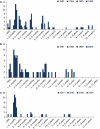Decreasing uptake of predictive testing for Huntington's disease in a German centre: 12 years' experience (1993-2004)
- PMID: 18781186
- PMCID: PMC2986171
- DOI: 10.1038/ejhg.2008.164
Decreasing uptake of predictive testing for Huntington's disease in a German centre: 12 years' experience (1993-2004)
Abstract
In this retrospective study, we examined changes in decision-making for and against the predictive genetic test for Huntington's disease including 478 persons at risk who had undergone genetic counselling in one centre in Germany between 1993 and 2004. At the outset of the counselling procedure the majority of subjects (71%) wanted to make use of the test, yet the actual demand of the predictive test result declined from 67 to 38% over the years. In addition, the time interval between counselling session and blood withdrawal was reduced, as determined by the counselees: in 2000-2004 the majority of persons at risk made the appointment for blood withdrawal after the shortest possible time span. Demographic factors of the cohort remained comparatively stable in the investigated time period. An association was evident between the ratio of test usage and the counselling person. These and other possible factors influencing the time flow of predictive DNA testing are discussed. Further studies are necessary to investigate whether changes of test demand rates are a general phenomenon.
Figures


Similar articles
-
Genetic Counselling for Predictive Testing in Huntington's Disease in One Centre since 1993. Gender-Specific Aspects of Decision-Making.J Huntingtons Dis. 2015;4(1):87-98. J Huntingtons Dis. 2015. PMID: 26333260
-
Predictive testing for Huntington's disease: relationship with partners after testing.Clin Genet. 2004 Jan;65(1):24-31. doi: 10.1111/j..2004.00168.x. Clin Genet. 2004. PMID: 15032971
-
Attitudes of neurologists, psychiatrists, and psychotherapists towards predictive testing for Huntington's disease in Germany.J Med Genet. 1993 Dec;30(12):1023-7. doi: 10.1136/jmg.30.12.1023. J Med Genet. 1993. PMID: 8133501 Free PMC article.
-
Predictive testing for Huntington's disease.Brain Res Bull. 2007 Apr 30;72(2-3):165-71. doi: 10.1016/j.brainresbull.2006.10.023. Epub 2006 Nov 9. Brain Res Bull. 2007. PMID: 17352941 Review.
-
Predictive testing for Huntington's disease: a challenge for persons at risk and for professionals.Patient Educ Couns. 1998 Sep;35(1):15-26. doi: 10.1016/s0738-3991(98)00086-x. Patient Educ Couns. 1998. PMID: 9832893 Review.
Cited by
-
Current Overview of Spinocerebellar Ataxia Type 7 in Mexican Population: Challenges in Specialized Care for a Rare Disease.Int J Mol Sci. 2024 Oct 6;25(19):10750. doi: 10.3390/ijms251910750. Int J Mol Sci. 2024. PMID: 39409079 Free PMC article. Review.
-
[Newborn screening as a predictive genetic test: principles and challenges].Wien Med Wochenschr. 2012 Apr;162(7-8):168-75. doi: 10.1007/s10354-012-0062-7. Epub 2012 Mar 28. Wien Med Wochenschr. 2012. PMID: 22451084 German.
-
Quality issues concerning genetic counselling for presymptomatic testing: a European Delphi study.Eur J Hum Genet. 2015 Nov;23(11):1468-72. doi: 10.1038/ejhg.2015.23. Epub 2015 Feb 18. Eur J Hum Genet. 2015. PMID: 25689925 Free PMC article.
-
Predictive testing for inherited prion disease: report of 22 years experience.Eur J Hum Genet. 2014 Dec;22(12):1351-6. doi: 10.1038/ejhg.2014.42. Epub 2014 Apr 9. Eur J Hum Genet. 2014. PMID: 24713662 Free PMC article.
-
22 Years of predictive testing for Huntington's disease: the experience of the UK Huntington's Prediction Consortium.Eur J Hum Genet. 2016 Oct;24(10):1396-402. doi: 10.1038/ejhg.2016.36. Epub 2016 May 11. Eur J Hum Genet. 2016. PMID: 27165004 Free PMC article.
References
-
- The Huntington's Disease Collaborative Research Group A novel gene containing a trinucleotide repeat that is expanded and unstable on Huntington's disease chromosomes. Cell. 1993;72:971–983. - PubMed
MeSH terms
LinkOut - more resources
Full Text Sources
Medical

